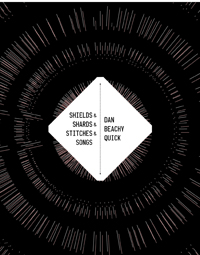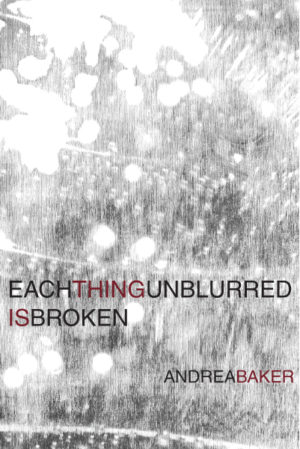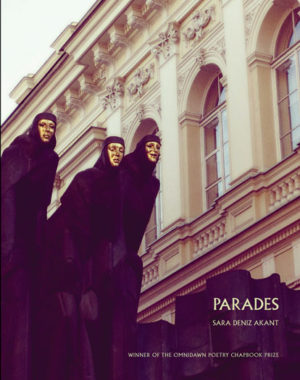Description
Transfer of Qualities addresses the uncanny and myriad ways in which people and things, but also people and those around them, exchange qualities with one another, moving in on, unsettling: altering stance, attitude, mood, gesture. Each entry in the book probes the dissolving boundaries between those sharing space with one another; and the various cross-genres in the book—prose poem, creative non-fiction, personal essay—echo the theme of inter-dependence. Material things often seem amazingly alive and tropic—a puppet or toy, a plate, a rug underfoot, a dim photograph on the wall across the way—and this collection follows in the footsteps of other authors also obsessed with the boundaries between life and death, the moving and the still, the stone-like book and the vivid stirring within the pages. There are many authors behind Transfer of Qualities, but the major genie of the piece is Henry James whose musings on his own, The Sacred Fount, provided the book’s title and direction.
Long-list nominee for the 2013 National Book Award for Poetry
One of Publishers Weekly‘s Best Books of 2013
One of NPR’s Best Books of 2013
Martha Ronk’s Transfer of Qualities belongs to the same tradition as Stein’s Tender Buttons and Ponge’s Le Parti pris des choses, but Ronk’s homage to the “not-me” of objects, and of others, is suffused with an elegance, melancholy, and intimacy all her own. Her meditation offers quiet, multiple, and profound insights into intimacy, grief, and the “residue of lost time.” In the words of Henry James—patron saint of Transfer—this generous book is “disposed for human use and addressed to it.” It truly gives, and “gives out.”
Maggie Nelson, author of The Art of Cruelty: A Reckoning
Ronk’s latest collection gathers together the everyday and the particular in order to think through—feel through—how it is that the material lives of things and objects make claims upon us and we upon them. These prose pieces offer again and again a subtlety and brilliance that leaves no thing short of voice and intensity. To read this work is to fall back into the world and all the ways it means its materiality.
Richard Deming, author of Listening on All Sides: Toward an Emersonian Ethics of Reading
About the Author
Reviews
Excerpt
Martha Ronk is the author of nine books of poetry, including Partially Kept (Nightboat Books), Vertigo (Coffee House), a National Poetry Series Selection, and In a landscape of having to repeat (Omnidawn), a PEN/USA best poetry book 2005, and Why/Why Not (University of California Press). She has also published a fictional memoir, Displeasures of the Table, and a collection of fiction, Glass Grapes and other stories (BOA Editions 2008); her poetry is included in the anthologies Lyric Postmodernisms (Counterpath Press), American Hybrid, (Norton), and Not For Mothers Only (Fence). She had residencies at Djerassi and The MacDowell Colony, and taught summer programs at the University of Colorado and Naropa; in 2007 she received an NEA Award. She worked as editor for Littoral Books and The New Review of Literature, and is the Irma and Jay Price Professor of English at Occidental College in Los Angeles, teaching Renaissance Literature and Creative Writing.
A brief interview with Martha Ronk
(conducted by Rusty Morrison)
I have been an ardent reader of your books since I happened upon Eyetrouble. I recall when you read at Cody’s Books in Berkeley, I think you where you reading from Why/Why Not. I introduced myself and had the audacity to ask you if you’d let Omnidawn publish a book of yours. You were so gracious! And even more marvelous is the fact that you gave us In a landscape of having to repeat, which remains one of my most beloved books. I keep it at my writing table still. It won Omnidawn our first major award, the PEN USA Poetry Prize. It’s a privilege to bring out this new book, Transfer of Qualities. I saw poems, prose poems, from it, I think in Colorado Review? And I recall feeling that I absolutely had read more of the work, and I lusted to publish it! It is an honor to be able to do so. The work in it has your unique sensibility, and yet it is unlike much of your past work. Could you say a bit about how you see the collection?
Transfer of Qualities addresses the uncanny and myriad ways in which people and things, but also people and those around them, exchange qualities with one another, moving in on, unsettling: altering stance, attitude, mood, gesture. Each entry in the book probes the dissolving boundaries between those sharing space with one another; and the various cross-genres in the book—prose poem, creative non-fiction, personal essay—echo the theme of inter-dependence. Material things often seem amazingly alive and tropic—a puppet or toy, a plate, a rug underfoot, a dim photograph on the wall across the way—and this collection follows in the footsteps of other authors also obsessed with the boundaries between life and death, the moving and the still, the stone-like book and the vivid stirring within the pages.
How/why did you begin Transfer of Qualities? Which poem or poems were the first you wrote?
I began this project with my own experiences in the potency of tropic objects around me, in my somewhat vertiginous experience when objects in my house are relocated, in my interest in ceramic or glass bowls that became manifest to me after the shelves were full. Obviously, I was very influenced by Henry James (the title is a quotation from him) and all his focus on the power of objects in The Golden Bowl and The Spoils of Poynton, the ways they seemingly press against, even determine the relationships of the characters. More specifically, I became interested in photograms through the work of Man Ray and Moholy-Nagy and the ways in which again, objects seem to press against one’s very skin; with other objects, like books, clearly there is no way I could not have thought about making them, holding them, collecting them. As a boy my son collected “found objects” and I think one of my first poems was of a piece of scrap metal I found on a walk on Kings Road in Vermont. Finally, I have a colleague, the artist Mary Beth Heffernan, who was making life-sized cyanotypes of the outlines of clothing (seams of a suit, a dress) at the time I was writing; they are haunting images of material stuff just coming into or going out of being.
Would you talk about the relation of the title to the text?
I tried to create a book in which prose poems, essays, and creative non-fiction pieces transferred qualities with one another; that is, I hoped that distinctions blurred enough to match the title.
I wanted the book to try to present the idea that categories, useful as they often are, can also allow for some merging and playful exchange. The poem’s title might also suggest a definition that the prose poem itself would deform. (No doubt this is irrelevant, but: Alice Munro’s story, “Comfort,” concludes with a wife tossing her husband’s ashes, but this action is given by way of an image that is amazingly “unrelated” to the narrative; it is a poetic moment of bravura, I think, that both closes and refuses to close the story.) Several years ago, I taught a course entitled “Hybrid Literature” which included poetic fiction from Virginia Woolf and Marcel Proust, for example, and narrative poems such as The Autobiography of Red and Paris Spleen.
Manuscripts often undergo revision before reaching their published form. Would you discuss your relationship to revision?
I revise a great deal, but never enough, and often am helped by suggestions from other poets and editors. I usually compose in a sort of trance or “state” of some sort where I am captivated by an image or rhythm or concern; trying to make something of this that is communicable depends on returning to this initial draft time and time again. Alexander Pope was right: the longer the better.
Who are the authors with whom you feel a kinship? Who influenced Transfer of Qualities? Who are you reading currently?
There are many authors behind Transfer of Qualities, but the major genie of the piece is Henry James whose musings on his own, The Sacred Fount, provided the book’s title and direction. In addition to James, the work is influenced by Walter Benjamin, numerous photographers and critics, Baudelaire, Francis Ponge, Virginia Woolf, and many writers who have examined the nature of things.
Many of my books have been influenced by literary sources and by a firm belief in dialogue with the language of others, in the interdependence of reading and writing. Why/Why Not is a collection of poems focused on Hamlet’s inability to decide, the title an echo of his “to be or not to be” monologue. Vertigo, my book on the confusions of memory, was written as an homage to W.G. Sebald’s book of the same name; and the long, somewhat convoluted poetic lines are echoes of Sebald’s efforts to capture memory in long sentences. Freud’s essays on repetition and the uncanny stand behind In a landscape; and Sir Thomas Browne’s Garden of Cyrus specifically influences and provides phrases for Partially Kept.
Would you tell me a bit about yourself? Anything you are willing to share that might not be in your short bio that is published in the book?
The major influence in my life is my career as a professor of English literature; I have always taught poets, especially Shakespeare, Milton, John Donne, George Herbert; and more contemporary ones as well, Wallace Stevens being my favorite. Teaching and scholarship often rest on the asking of questions, the examination of technique and meaning. I began writing my own poetry more seriously when I needed to ask questions of a new geography, specifically the desert, when I moved to Los Angeles from the East Coast. It stunned me; part of my work at that time appears in Desert Geometries; and I think each project since is the result of having been stunned again in a similarly unnerving way. As I was working on Transfer of Qualities I was also returning to work in a ceramics studio, which I hadn’t done since my son was born; working with clay makes one very aware of objects in a state prior to themselves.
I had residencies at Djerassi and The MacDowell Colony, and taught summer programs at the University of Colorado and Naropa; in 2007 I received an NEA Award. I worked as editor for Littoral Books and The New Review of Literature, and I am the Irma and Jay Price Professor of English at Occidental College in Los Angeles, teaching Renaissance Literature and Creative Writing.
You chose the image that is used in the cover design for this book. I believe you are friends with the photographer? Would you be willing to describe your affinities to her work and/or to this particular photograph?
I know the young photographer and artist, Farrah Karapetian, through my step-daughter who has been friends with her since childhood. I loved her series of glass bottle photograms because they are images of fragile, transformed, and broken—some even melted—bottles. I saw these objects as akin to what I was after; they are both familiar and strange.
Ronk’s collection of “various objects,” books, photograms, people and portraits dominate the collection, which moves from prose to lineated poems, to essays, to brief passages of nonfiction, seguing into topics of representation, death, mourning, love, and intimacy with the physical world.
Ronk is a precise poet, and the collection opens with a series of prose poems dedicated to discrete objects handled so carefully that they seem to return our gaze. A gap in the sky between branches forms a “zigzag pattern across the ground, the one leafless twig glowing in the black half, the other darkly outlined in the white half, the way we are marked by our gestures.” While the poem ostensibly describes a meeting of lovers, it also suggests the bestowal of life in an impending divine touch.
Plying around edges of self-and-object, self-and-self, self-and-other, Ronk shows us that while we cannot mind-read, we certainly and necessarily connect otherwise. As W. James ultimately saves us from isolation by the fact that sensation and physical encounter with the world are the source of thought, Ronk’s writing explores the way that “Each shift, each bend of one’s body, turns out to be related to the potency of objects” (“Talking to Things,” 47). Objects—which include both the concrete (bowls, jars, tiny seashells threaded on a sting), the abstract (lectures, absence, air) and the in-between (books, photographs, quotations)—anchor us to the world and transform us: “Nothing has an essence of its own, but is what it is only in relation to all that is around” (“Talking to Things,” 47).
Such is the nature of Martha Ronk’s poetry, where complication is a process and a prism and a paean to the great intellectual wealth that is Greater Complication Awaiting You! There are other layers at work in Transfer of Qualities. For instance, Ronk writes poems about the mediating layer between objects and our experience of their reality. When we look at a photograph of objects are we any less aware of their presence? When we look out the window, how are we not aware of the effect of a window framing our perspective. How far can Ronk extend her metaphor of object for memory or memory for object? I implore you to read this book and find out.
If Martha Ronk’s Transfer of Qualities was an object, it’d be one with arms, palms, maybe even fingernails. It’d have the kinds of appendages a reader blindly trusts to lead her into an unfamiliar world—one where liminality is king, where people, places, and things are constantly engaged in exchanges both playful and vicious. The central thesis of Ronk’s hybrid-genre text is that the boundaries between person and person, person and object, object and object are constantly in flux, each having a profound impact on one another. In this world of transference, it makes perfect sense that Ronk’s investigtation refuses to rely on the conventions of only one genre, instead drawing from the realms of poetry, prose, and the first-person essay, and folding them all together into one remarkably cohesive and emotionally-jarring book.
Martha Ronk places before us a series of such freighted objects—objective correlatives, dialectical images, call them what you will. These are objects—material or written—which collapse time, reshaping the perspectives of their owners. It may seem strange to the contemporary reader that such an occupation still bears our attention, especially when objects in our grasp tend to epitomize disposability (how quickly the iPhones replace themselves!), but Ronk’s work clarifies just how rare and crystallizing these moments of recognition tend to be.
Martha Ronk, in her necessary and luminous new book, Transfer of Qualities, explores more unexpected qualities of what an intimate life might mean—not simply our connections to others, nor, more solipsistically, one’s relationship to oneself, but that far more ubiquitous relationship, so common as most often to go unnoticed: our intimate life with objects.
A Lost Thing
You hate yourself when the object that defines you, or at least you
think it does, is lost or broken. It makes perfect sense: you are the
one who is lost and it’s your own fault, having left it behind in
a stranger’s room for where else but in the room of a stranger
would you leave it, inadvertent, shoddily careless, the enemy of
attachments. Or it is that you run through the room in a hurry—slow
down you hear someone say—rushing out the door, knocking it into
a thousand pieces, glass shattered on the floor, the frame twisted,
a strange disfiguration replacing the face—the photographic paper
marred by shards—and it’s not only the having done it that one
must live with—one’s own arm thrown carelessly through the air—
but the evidence of what was meant to be.



